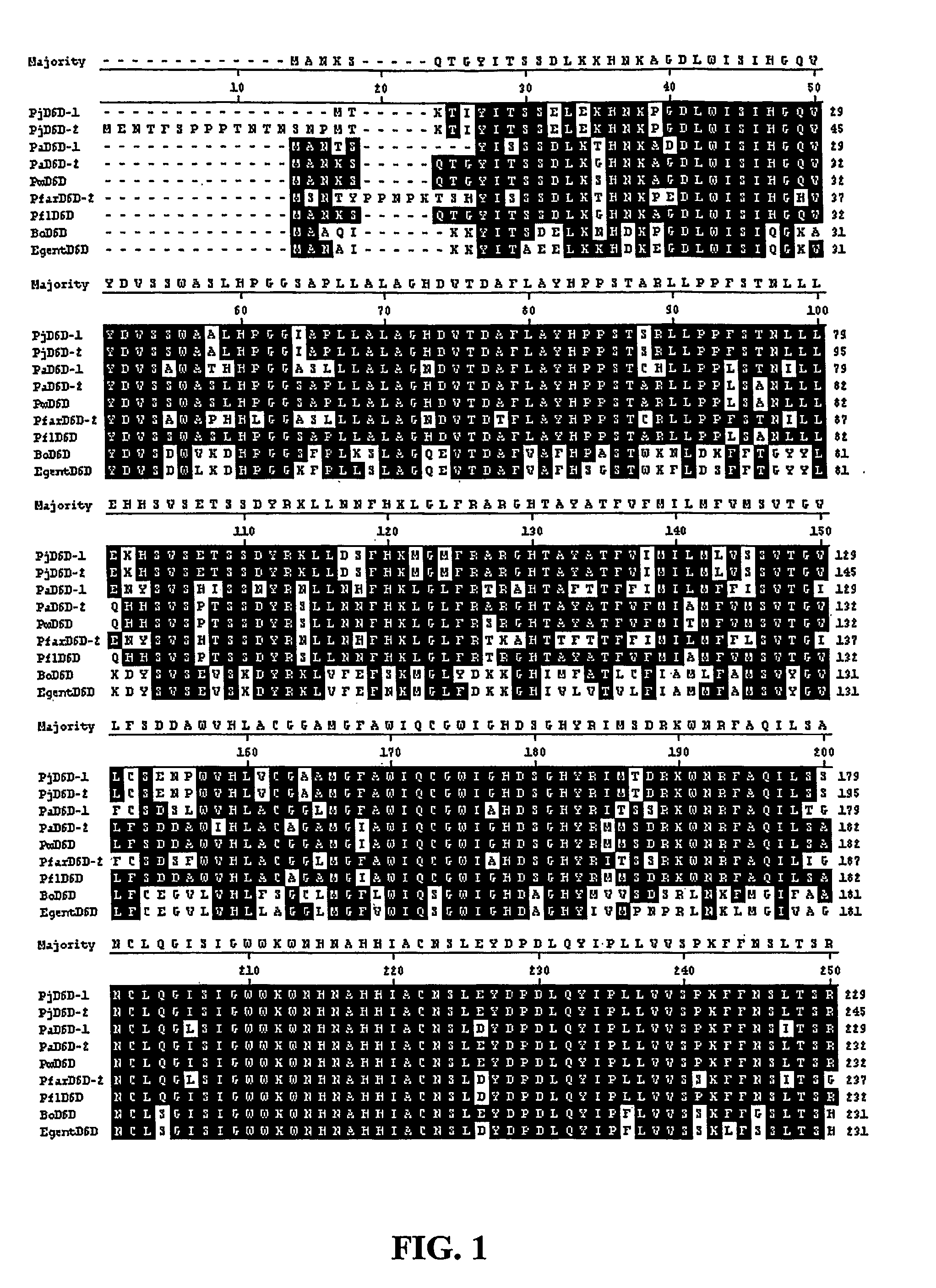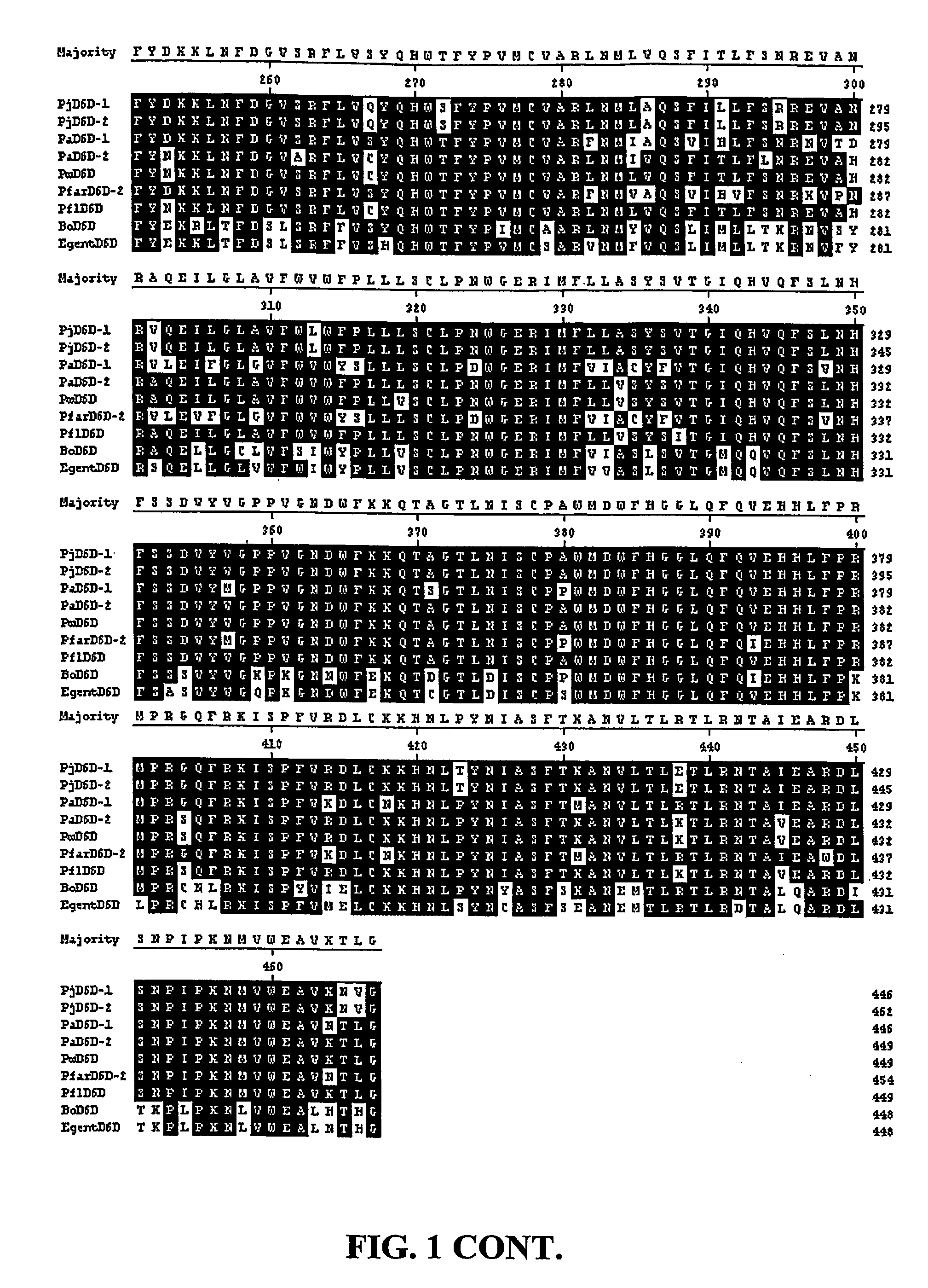Fatty Acid Desaturases From Primula
a technology of desaturases and primaria, which is applied in the direction of oxidoreductases, depsipeptides, plant/algae/fungi/lichens ingredients, etc., can solve the problems of unsatisfactory current availability of pufa, uncontrollable fluctuations in availability of natural sources of pufa, and depletion of fish stocks, so as to increase the sda content of the edible product, increase the ratio of omega-3, and increase the nutritional value of edible products
- Summary
- Abstract
- Description
- Claims
- Application Information
AI Technical Summary
Benefits of technology
Problems solved by technology
Method used
Image
Examples
example 1
Cloning of Primula juliae Δ6 Desaturase Sequences
[0100]Cloning of the Primula juliae Δ6 desaturase (PjD6D) was achieved by PCR amplification of a partial internal genomic DNA region using degenerate oligonucleotides, followed by bi-directional genomic walking. Total genomic DNA was isolated from P. juliae (Collector's Nursery, Battleground Wash.) using the DNeasy Plant Mini Kit (Qiagen, Valencia, Calif.), following the manufacturer's procedure. Initially, a 552 bp fragment corresponding to positions 687 to 1238 of SEQ ID NO:1 was isolated using degenerate oligonucleotides BO-1 For and BO-2 Rev as described by Garcia-Maroto et al. (2002). The fragment was cloned into pCR®4-TOPO® (Invitrogen, Carlsbad, Calif.) to yield the vector pMON83955 and the insert was sequenced. Primer sequences BO-1 For and BO-2 Rev were as follows:
BO-1 For:5′-ATMAGYATYGGTTGGTGGAARTGG-3′(SEQ ID NO:6)BO-2 Rev:5′-AATCCACCRTGRAACCARTCCAT-3′(SEQ ID NO:7)
[0101]To determine the genomic flanking sequence of the inser...
example 2
Yeast Transformation and Expression
[0106]Constructs pMON83950 (FIG. 3) and pMON67011 (FIG. 2) were introduced into the host strain Saccharomyces cerevisiae INVSc1 (Invitrogen), which is auxotrophic for uracil, using the PEG / Li Ac protocol as described in the Invitrogen manual for pYES2.1 / V5-His-TOPO. Transformants were selected on plates made of SC minimal media minus uracil with 2% glucose. Colonies of transformants were used to inoculate 5 ml of SC minimal media minus uracil and 2% glucose and were grown overnight at 30° C. For induction, stationary phase yeast cells were pelleted and re-suspended in SC minimal media minus uracil supplemented with 2% galactose and grown for 3 days at 15° C. When exogenous fatty acids were provide to the cultures, 0.01% LA (Δ9,12-18:2) was added with the emulsifier 0.1% Tergitol. The cultures were grown for 3 days at 15° C., and subsequently harvested by centrifugation. Cell pellets were washed once with sterile TE buffer pH 7.5, to remove the medi...
example 3
Plant Transformation and Expression of Primula juliae Δ6-desaturase
[0109]The activity of the P. juliae Δ6-desaturase was evaluated in soybean by combining it with a Δ15-desaturase from either Neurospora crassa (NcD15D), pMON77245 (FIG. 4), or Aspergillus nidulans (AnD15D), pMON77247 (FIG. 5). The vector pMON77245 was constructed in three steps. First P. juliae Δ6-desaturase (PjD6D-2) was placed behind the seed-specific 7S alpha′ promoter by digesting pMON67011 with Sse8387 I, followed by removal of the 3′ overhangs, and Sal I, and then ligating the resulting fragment into the EcoRI and filled-in XhoI sites of the expression vector pMON68527, generating the vector pMON77243. Second, the PjD6D-2 expression cassette was removed from pMON77243 by digesting with NotI, followed by a fill-in reaction, and then the resulting fragment was ligated into the EcoRV site of the 2 T binary vector pMON77244. Finally, a codon-optimized NcD155D (SEQ ID NO:17) under the control of a 7 S alpha seed-spe...
PUM
| Property | Measurement | Unit |
|---|---|---|
| Temperature | aaaaa | aaaaa |
| Fraction | aaaaa | aaaaa |
| Fraction | aaaaa | aaaaa |
Abstract
Description
Claims
Application Information
 Login to View More
Login to View More - R&D
- Intellectual Property
- Life Sciences
- Materials
- Tech Scout
- Unparalleled Data Quality
- Higher Quality Content
- 60% Fewer Hallucinations
Browse by: Latest US Patents, China's latest patents, Technical Efficacy Thesaurus, Application Domain, Technology Topic, Popular Technical Reports.
© 2025 PatSnap. All rights reserved.Legal|Privacy policy|Modern Slavery Act Transparency Statement|Sitemap|About US| Contact US: help@patsnap.com



